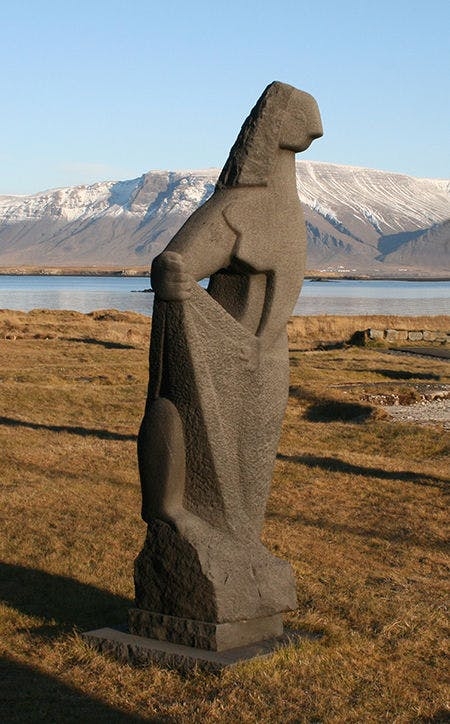Udstilling af islandsk kunst
The first exhibition of Icelandic art in Copenhagen
21.1.2016 — 11.9.2016

21.1.2016 — 11.9.2016
Curator
Dagný Heiðdal
Department manager of exhibitions
Birta Guðjónsdóttir
Texts
Björg Erlingsdóttir
Dagný Heiðdal
Harpa Þórsdóttir
Júlíana Gottskálksdóttir
Rakel Pétursdóttir
Steinar Örn Atlason
Installation and preparation
Baldur Geir Bragason
Elín Guðjónsdóttir
Geirfinnur Jónsson
Hrafnhildur Guðmundsdóttir
Sigurður Gunnarsson
Svanfríður Franklínsdóttir
Graphic Design
Studio Studio Arnar Freyr Guðmundsson and Birna Geirfinnsdóttir
Hildigunnur & Snæfríð
Lighting
Rafsel

At the beginning of the 20th century, pioneering work was taking place in Iceland in visual art, and ever more Icelanders went into art. Visual art was one of the factors which contributed to the Icelanders establishing a national identity, at a time when they were gaining self-determination, step by step – and artists' interpretation of Icelandic nature played a crucial role. In their work the artists express their feelings about their country in visual form, speaking directly and untrammelled by language.
Promotion of Icelandic art abroad goes back nearly 100 years, beginning with an exhibition held by the Dansk-Islandsk Samfund (Danish-Icelandic Society) in March 1920: Fem islandske Malere/Five Icelandic Painters at the Georg Kleis gallery on Vesterbrogade 58, Copenhagen. The objective of the Society was, and is, to enhance knowledge of Iceland among Danes, and vice versa. The five painters whose work was shown were Ásgrímur Jónsson (1876–1958), Guðmundur Thorsteinsson, known as Muggur (1891–1924), Jón Stefánsson (1881–1962), Kristín Jónsdóttir (1888–1959) and Þórarinn B. Þorláksson (1867–1924), a total of 158 works: oils, watercolours, drawings, prints, etc. The largest number of works were by Muggur (80), who often sought inspiration in Icelandic folklore. Landscapes, however, accounted for a majority of the paintings exhibited, along with a number of portraits.

The exhibition was organised at short notice; this is said to explain in part why only five artists were included. Hence it was not an overview of Icelandic art, although that had been the initial intention. It was referred to as a “small” exhibition, both in the catalogue and in the press; but it was the largest exhibition of Icelandic art that had been held in Denmark – or anywhere else outside Iceland. The exhibition received considerable coverage in the Danish press, and generally favourable reviews – although not universally. Some commentators felt there was a new and exotic element to the exhibition, while others claimed to see little indication of national character or uniquely Icelandic art, apart from the subject matter of Icelandic nature.
During the two weeks of Five Icelandic Painters at the premises of art dealer Georg Kleis, over a thousand people visited, including the King and Queen of Denmark. The paintings sold quite well.

In December 1927 Icelandic art was for the first time presented generally in Copenhagen in Udstilling af islandsk kunst /The Icelandic Art Exhibition at Charlottenborg, one of the most prestigious exhibition galleries in the city, attached to the Royal Danish Academy of Art. The show comprised 243 paintings and drawings by twelve artists: Ásgrímur Jónsson, Finnur Jónsson (1892–1993), Guðmundur Einarsson of Miðdalur (1895–1963), Guðmundur Thorsteinsson (Muggur), Gunnlaugur Blöndal (1893–1962), Jóhannes S. Kjarval (1885–1972), Jón Stefánsson, Jón Þorleifsson (1891–1961), Júlíana Sveinsdóttir (1889–1966), Kristín Jónsdóttir, Sigurður Guðmundsson (1833–1874) and Þórarinn B. Þorláksson. Also exhibited were seven women's national costumes, silver objects, woodcarvings and old bookbinding. The works exhibited belonged to the artists, or were borrowed from public or private collections. At the end of the exhibition 141 of the works of art went on to Germany, where the exhibition was shown in Lübeck, Kiel, Hamburg and Berlin in collaboration with the Nordic Society in Lübeck.
This major exhibition was held on the initiative of Danish journalist Georg Gretor, who had made the acquaintance of Icelandic artists when travelling around the country in 1926. His objective was to present Icelandic art to art critics in other countries, and it was thanks to his efforts that Danish newspapers undertook to pay the costs of the exhibition in Copenhagen. The Icelandic authorities met the costs of preparation in Iceland. Matthías Þórðarson, Director of the National Museum, was appointed on behalf of the government. He assisted Gretor in the selection of works in Iceland, and accompanied them to Denmark aboard the ship Gullfoss, which carried 264 works to Copenhagen. On arrival more works were added, from artists working in Denmark and from private collections there. In addition to Matthías Þórðarson and Georg Gretor, author Poul Uttenreitter and artists Jón Þorleifsson and Júlíana Sveinsdóttir took part in hanging the exhibition in the galleries at Charlottenborg. Not all the works sent from Iceland were selected to be hung, to the disappointment of some. But Gretor placed emphasis on making a careful selection of works. He explained in an interview:
But the most important matter is that the exhibition should be as good as possible. I am of the view that Icelandic painting has remarkable and important attributes, which do not exist anywhere else. These attributes must be showcased in the exhibition. And should that be done so successfully that foreign art critics notice the national attributes and deem them to have enduring artistic value, that will blaze a trail for Icelandic exhibitions abroad – for Icelandic art in the consciousness of the great nations. (Morgunblaðið, 22 November 1927)
The Icelandic Art Exhibition was ceremonially opened at Charlottenborg on 10 December 1927 in the presence of the King and Queen of Denmark, government ministers, ambassadors and other dignitaries. Both the Icelandic and the Danish press wrote extensively about the exhibition and published pictures. The show attracted large numbers: on the first Sunday, for instance, visitors numbered 700.

The exhibition received generally favourable reviews; Icelandic visual art was deemed more potent and deeper than might be expected of a nation of only just over 100,000 people, with no national artistic tradition. The landscapes were singled out for attention – as Icelandic nature was so different from what people were accustomed to seeing. Nearly half the works shown sought inspiration in Icelandic landscape. The critics were in general agreement that Stefánsson was the best of the Icelandic painters, while the works of Finnur Jónsson and Gunnlaugur Blöndal were judged to be the most avant-garde. When the exhibition closed on 23 December, 16 works had sold. Four were purchased by the Danish National Art Collection.
In its time the Icelandic Art Exhibition attracted great attention, and it was later seen as having given a boost to Icelandic artists and the development of Icelandic art: the exhibition laid the foundation for connecting Iceland with western artistic tradition, while also manifesting the specifically Icelandic character of the art.
The Icelandic Art Exhibition in Copenhagen and northern Germany 1927–1928 marks a turning-point, as the first public promotion of Icelandic art abroad. It marks the end of the first stage of modern art in Iceland, which was characterised by pioneering work by artists and others who took part in creating an art world in Iceland. The exhibition also marked the start of new period of public involvement in art in Iceland: in 1928 Alþingi (the Icelandic Parliament) enacted legislation to found a Cultural Fund and a Cultural Council, thus ensuring for the first time annual allocations for purchase of works of art by the government.
The present exhibition at the National Gallery includes only some of the works shown in Copenhagen in 1920 and 1927. Most are from the Gallery's collection, while others have been borrowed from other collections, and from corporate and private owners. Information on the works included in the exhibitions in 1920 and 1927 is from catalogues, press coverage, photographs, and a pamphlet, Islands Kultur und seine junge Malerei (Icelandic Culture and its Early Painting), written by Georg Gretor in 1928. In many cases it is hard to determine exactly which works were shown, guided solely by the artist's name and the title of the work. This applies especially to the 1920 exhibition







